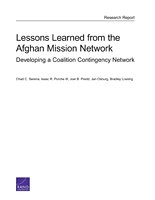| 来源类型 | Research Reports
|
| 规范类型 | 报告
|
| ISBN | 9780833085115
|
| 来源ID | RR-302-A
|
| Lessons Learned from the Afghan Mission Network: Developing a Coalition Contingency Network |
| Chad C. Serena; Isaac R. Porche III; Joel B. Predd; Jan Osburg; Brad Lossing
|
| 发表日期 | 2014
|
| 出版年 | 2014
|
| 页码 | 38
|
| 语种 | 英语
|
| 结论 |
Enhancing collaboration among partner nations and enabling interoperability on the AMN required relaxing various security constraints that had slowed the transfer and/or accessibility of mutually beneficial data and precluded sharing of needed information.- Information sharing among diverse mission partners required higher levels of collaboration, which in turn required modifying information technology (IT) security boundaries and designs. The number of different networks and security domains used to plan and conduct missions was reduced as "need-to-know" restrictions were relaxed to enable a "need-to-share" culture.
- Interoperability is reduced when networks are built upon multiple databases spread across a number of security domains. To mitigate potential interoperability losses, future coalition networks need to be preplanned and designed to exist within a single or a small number of security domains.
Many of the benefits realized from the AMN were the result of a development and testing process focused on documenting user steps for operational tasks conducted in the field. - Operation Enduring Freedom "mission threads" individually and collectively comprised the types of missions conducted throughout Afghanistan and provided the baseline for the data organization, sharing, and analysis at the center of the AMN.
- Operation Enduring Freedom "mission threads," and other commonly defined and understood mission threads, should be used to guide the development of future coalition data-sharing enterprises.
Extra-theater testing, assurance, and validation efforts like those conducted by the Joint Interoperability Test Command's (JITC) Coalition Interoperability Assurance and Validation (CIAV) program enable controlled network experimentation and testing pursuant to network solutions that can later be replicated in theater.- Dedicated Army and Defense Information Systems Agency (DISA) facilities and personnel enabled the rapid testing and integration of a complex and continuously evolving network. These facilities and personnel provided methods for immediately addressing gaps identified in the network. They also provided assessments of technologies prior to their introduction and operational fielding into the AMN enterprise.
- The decision to leverage Army and DISA facilities and personnel for network testing and integration marked a turning point in the functional development of the AMN for the following reasons: (1) it freed warfighters to continue with the conduct of their various missions; and (2) it allowed warfighters to take advantage of expertise and systems that might not necessarily be available in theater.
|
| 摘要 |
- A common mission network will likely be needed in every region where the United States conducts coalition operations.
- The Army should establish a persistent capacity for the testing and validation of coalition network capabilities and equipment.
- Appropriate requirements documents should reflect the information-sharing needs associated with ubiquitous coalition operations.
|
| 主题 | Afghanistan
; Global Security
; Military Information Technology Systems
; Military Intelligence
; Security Cooperation
|
| URL | https://www.rand.org/pubs/research_reports/RR302.html
|
| 来源智库 | RAND Corporation (United States)
|
| 资源类型 | 智库出版物
|
| 条目标识符 | http://119.78.100.153/handle/2XGU8XDN/107639
|
推荐引用方式
GB/T 7714 |
Chad C. Serena,Isaac R. Porche III,Joel B. Predd,et al. Lessons Learned from the Afghan Mission Network: Developing a Coalition Contingency Network. 2014.
|
|
文件名:
|
1396616059616.gif
|
|
格式:
|
GIF
|

|
文件名:
|
RAND_RR302.pdf
|
|
格式:
|
Adobe PDF
|
除非特别说明,本系统中所有内容都受版权保护,并保留所有权利。